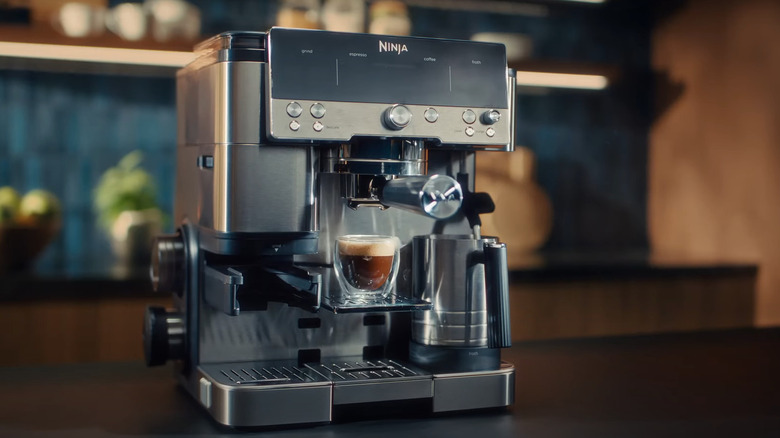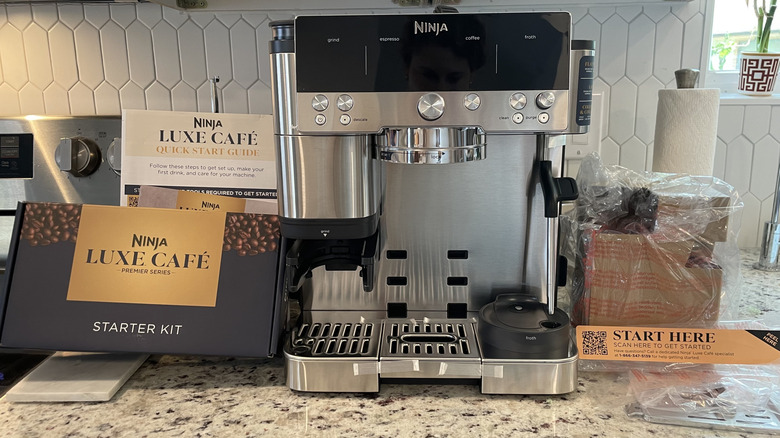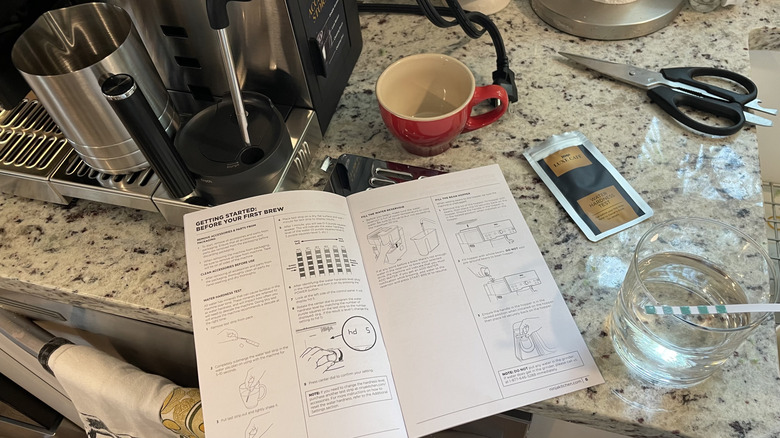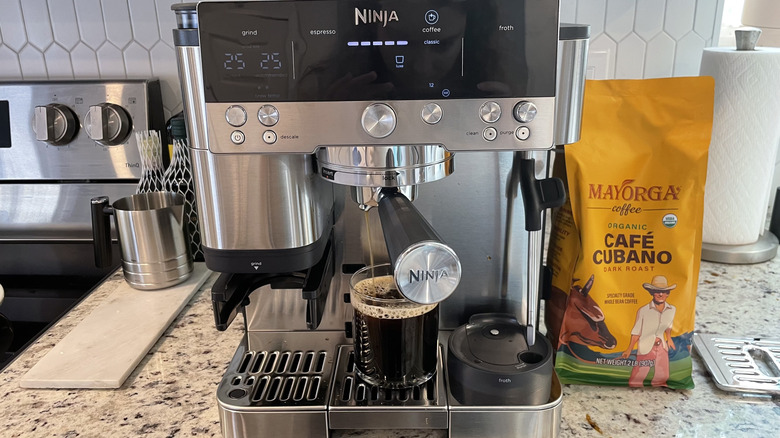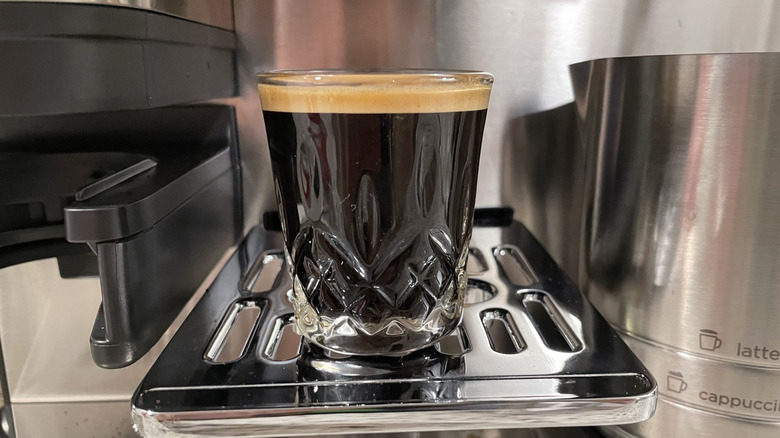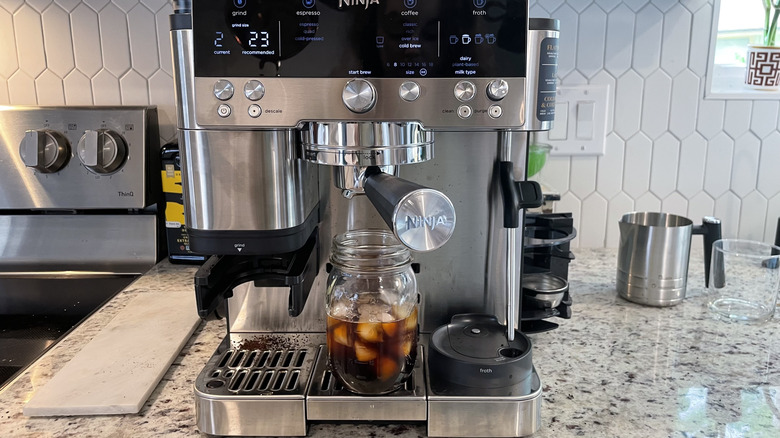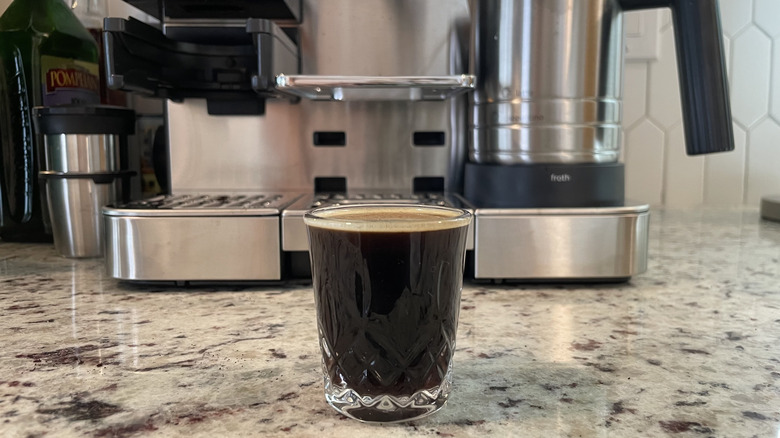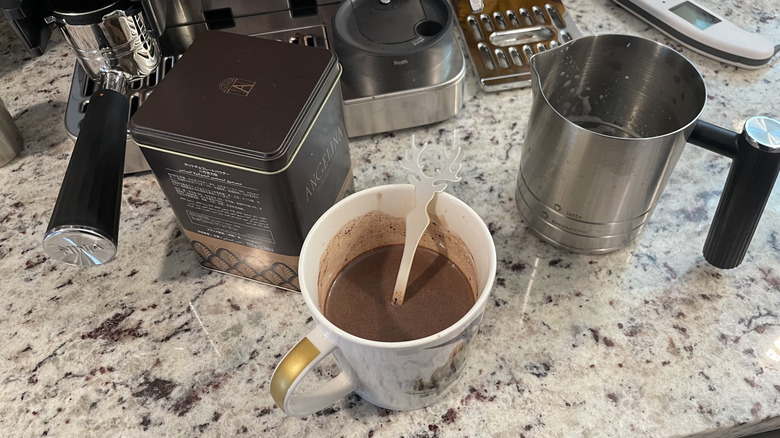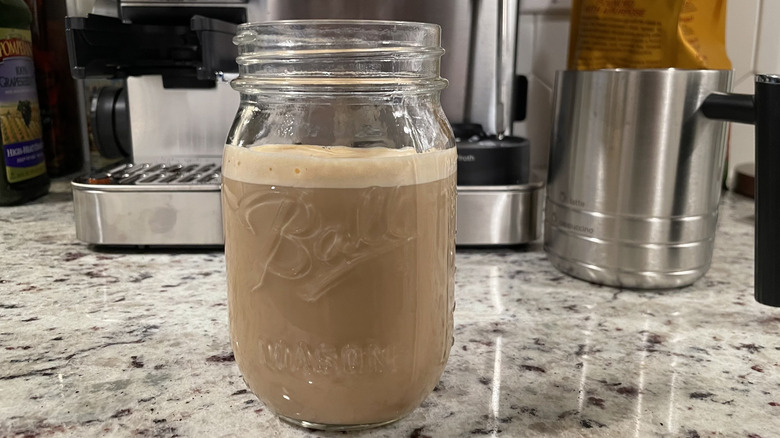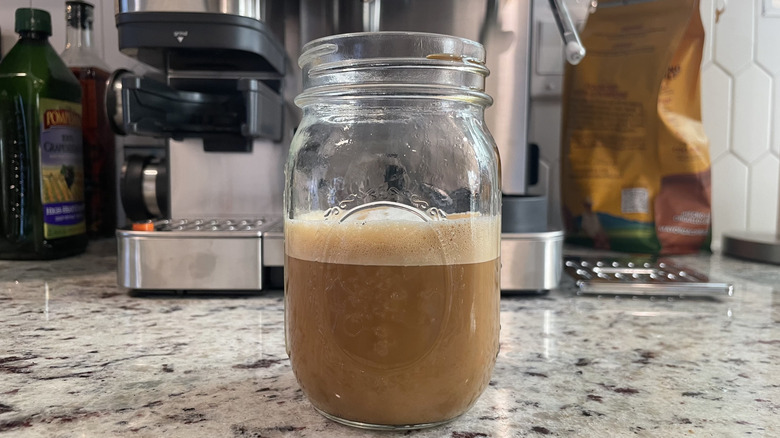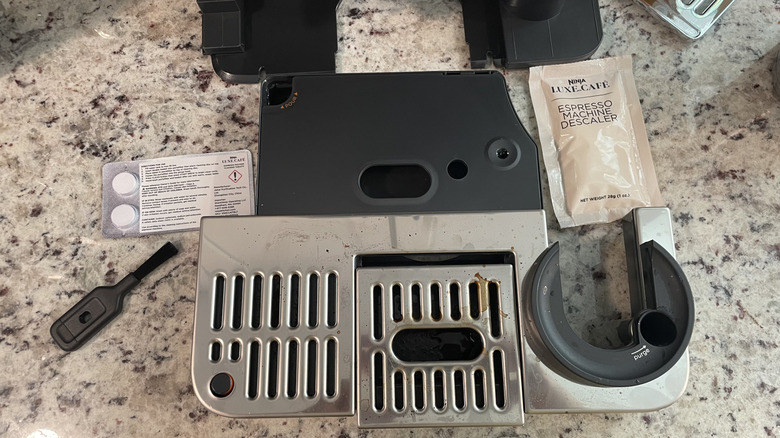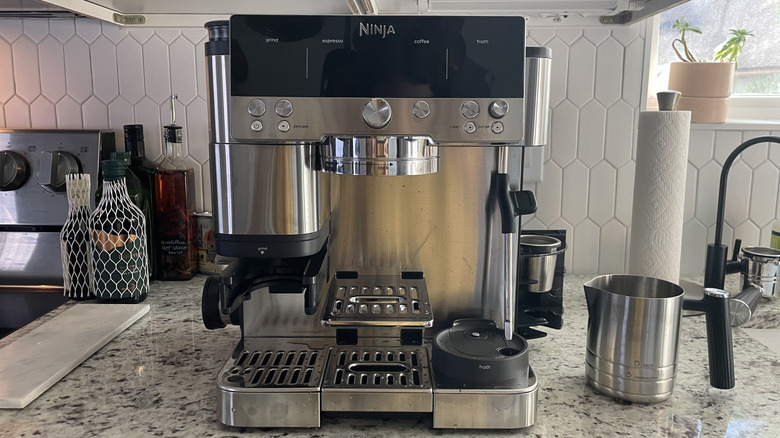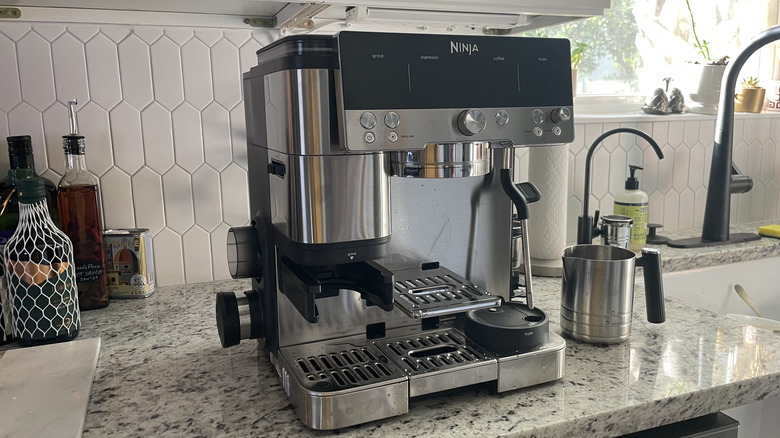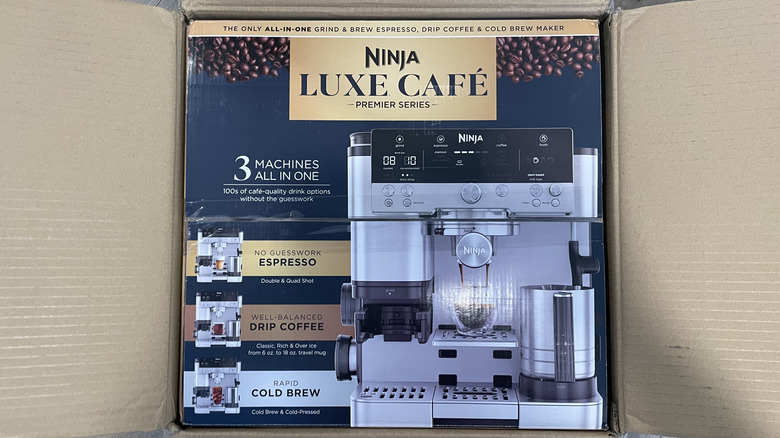Ninja Luxe Café: It's $500, But Here's Why That's Actually A Steal
We may receive a commission on purchases made from links.
While I'm an ardent coffee drinker (two cups a day or else), I've always been intimidated by the fancy espresso machines on the market. After all, it can feel like you need to have a barista certification in order to brew an espresso as flawlessly as the paid professionals do. In the past, Nespresso has been my go-to for the easiest and fastest espresso maker for my at-home cravings, but it lacks a lot of bonus good stuff (milk frother, grinder, etc.).
Enter the Ninja Luxe Café ($499.99). This multi-purpose machine promises to deliver an uncomplicated espresso machine with all the additional bells and whistles to make cold brew coffee and drip coffee, as well as a built-in frother and steamer. In one fell swoop, the Ninja Luxe Café eliminates three to four different pieces of equipment you might need to create espresso or coffee. This would make it one of the more efficient and affordable coffee makers on the market. But does it deliver?
I spent a week getting to know the ins and outs of the Ninja Luxe Café, determining whether this all-in-one machine was easy enough to use and if it was able to produce quality café-style espresso and coffee. From setup to brew, I'll walk you through my experience.
A closer look at the Ninja Luxe Café
The Ninja Luxe Café has three main features: The first is its grinder, which has the signature built-in Barista Assist Technology. This essentially combines a grinder with a sensitive scale that will measure out exact amounts of coffee grounds for espresso, drip coffee, and more. It's an incredibly useful feature, as one of the greatest headaches behind at-home brewing can be the switch from espresso to ground coffee. Whole beans are loaded into a hopper, then, once the size and grind of coffee is selected, the machine will grind an exact amount directly into the portafilter.
The second feature encompasses the actual brewing part of the machine. With a dial, users can select to brew everything from a double shot of espresso to a 16-ounce cold brew. While the drip coffee and espresso options for the maker are expected elements, the cold brew and cold-pressed espresso options are an exciting addition (think espresso martini).
The final attractive feature is the sophisticated milk frother that works with both dairy and nondairy creamers, which can make steam, frothed, and cold-foamed versions. This is a smart addition, as many coffee lovers have made the switch to alternative dairies.
Assembling the Ninja Luxe Café
Unpacking the Ninja Luxe Café may have been the most daunting part of this review. There were a lot of gadgets and equipment to unwrap (portafilter, double basket, luxe basket, funnel, tamper, milk jug, and cleaning brush) complete with several informational booklets — a recipe guide, a quick start guide, and an official owner's guide. Though it can seem like an overwhelming amount of reading material, I found each one fairly easy to understand.
The machine is already assembled when you pull it from its box. The initial maintenance focuses on getting your water and coffee beans in the right set-up. First, you'll want to test your tap water hardness. Your tap water will definitely affect the taste and texture of your espresso, so Ninja supplies users with a handy test strip. I had very soft water, so set my dial to zero.
Next, I added whole coffee beans to the hopper, a funnel container above the grinder. Immediately after, I needed to flush out the machine, brewing a plain hot cup of water (about 12 ounces) with an empty portafilter attached (it won't run otherwise). After that, the Ninja Luxe Café was open for brewing business.
The drip coffee test
Starting simple, I decided to brew a plain cup of joe. First you have to set up your portafilter, a container with a handle that holds the coffee grounds for brewing. For drip coffee, the luxe (largest) basket has to be fit into the protafilter; it will hold more grounds than the double.
Once I selected "classic" and a 12 ounce size with the center dial, I put the funnel over the portafilter and locked it into the grinding cradle. For drip coffee, the machine will suggest you set the grinder to 25, a fairly coarse grind. Once matched up, you can press the grind button and the Barista Assist Technology works its magic. I then locked the portafilter into the main hub, and hit brew. For temperature, I selected medium as the manual mentioned dark roasts (what I was using) needed a low (1) to medium (2) temp. Light roasts can go up to high (3).
I managed all of this correctly on my first try — I'm as surprised as you are — so I have to give immediate points for clear instructions. Flavor-wise, this was a mighty strong cup of coffee, as intense as I've had at home. It was a bit strong for my taste, so I made a smaller cup (8 ounces) my second go and decreased the temp to 1. Voilà, perfect coffee.
The espresso test
Espresso and coffee are two very different beasts, which is why people invest in a fancy espresso machine in the first place. With that in mind, I considered this portion of testing to be the most important of all, because at its very heart, the Ninja Luxe Café is promising excellent espresso at home.
The process to make an espresso was much the same as the drip coffee, only dials were twisted to a few different settings. First, I swapped in the double basket (meant for all espresso grounds) in the portafilter, and selected "espresso" on the main dial. Immediately, my grinder prompted me to switch the grind setting from 25 to 12 (extra fine), as espresso requires a much finer grind. Once it finished grinding (it beeps when done), I was prompted to tamp down the grounds, which helped keep it from overflowing. It brewed quickly, and I enjoyed watching a satisfying rim of crema form at the top — this delicate foam produced during brewing is usually the litmus test for a good cup of espresso.
Once again, I nailed this all on my first try. The crema helps the espresso flavor linger on the tongue, calling to mind a much more expensive set-up than a home brew. As this was an espresso, it had a strong, pungent flavor that I could mellow out nicely with a bit of sugar, or enjoy plain.
The cold brew test
Moving onto cold brew, another function I was excited to try, this promised to make a strong concentrate that I could add ice to and not feel like it tasted like watered-down coffee as the ice melted. This is the main difference between cold brews and iced coffees: strength of flavor. Indeed, the Ninja Luxe Café also has an "over ice" coffee option, which gives you regular, cool coffee. It works well, but the cold brew feature eclipses it easily.
If you're switching immediately between a hot drink and a cold one, the machine will ask for a "rinse," which is basically a quick purge of hot water. After that, you'll follow the same formula as making drip coffee (adjusting grind and basket size as needed). In a little less than five minutes, my dark roast (the best for cold brew) was ready.
I didn't figure this out on the first try, but chalk that up to user ignorance rather than faulty instructions. When I first made cold brew, I neglected to put ice in my cup, which meant I thought I was getting much less than eight ounces of coffee. When I did finally understand my dumb mistake (it makes eight ounces of coffee WITH ice), I was able to enjoy this feature immensely. Sweetened with cold foam, this was as good as a cold brew I've had, and I think it can stand up to any chain variation out there.
The cold-pressed espresso test
Another revolutionary feature of this machine is its cold-pressed espresso function. Cold-pressed espresso is made with cold water and high pressure, and it has a number of uses, but the most famous one is the beloved espresso martini. (You can use cold brew to make espresso martinis, too.) Of course, there are numerous recipes that can also benefit from some cold-pressed espresso, and the Ninja Luxe Café inspiration booklet has several sweet suggestions, like iced dirty chai and iced hazelnut lattes.
For cold-pressed espresso, I needed a slightly less fine grind (17) than the hot version. Otherwise, I followed the same steps as making a regular espresso and it came out just as easily. I'd say that the drip process goes a bit slower, but not anything drastic.
During tasting, I could hardly tell the difference between this shot and the hot one, minus temperature. Speaking of decreased temperature, I had less crema on my cold-pressed espresso than the hot version. This didn't affect flavor for me. If you plan to make espresso martinis, a quick toss in a shaker will help that foam reappear. I'm excited to use this as a shortcut to make iced caffeinated drinks, especially for the milk-heavy iced lattes.
The hot chocolate test
One of the few hang-ups I've noted with this machine is that it doesn't have a pure hot water function, which would help users create teas, flat whites, and hot chocolates. It seems like an oversight, as this machine has practically every other feature included. Still, the milk frother can help those who are craving a fancy hot chocolate.
The lowest setting on the milk frother wand is its "steam" option, which can heat perfectly portioned milk, cream, or other dairy to an ideal hot temperature (i.e., until it's steaming). For this test, I used the steamer to make a milk-based hot chocolate. I poured eight ounces of milk into the designated jug and then placed it under the wand. In just over three minutes, I had steaming milk ready for some hot chocolate mix to be poured in.
The result had just enough heat to melt the chocolate morsels in my fancy French cocoa mix, but it wasn't as smooth as it could be, and it was lukewarm. Commercial powder mixes will dissolve fine but I think traditional hot cocoa enthusiasts will be disappointed at the low heat of the milk. Of course, if you buy the Ninja Luxe Café for the hot chocolate, you may be missing the point.
Milk frother and steamer test
After the brief detour into the realm of hot chocolate, I dived into using the steamer/frother for what it was really intended for: making luscious lattes, cappuccinos, and cold cream-topped iced brews. With this helpful feature, I could, hypothetically, get very good at making some latte art. Indeed, if you're a pro, there's a manual frothing mode that you can use to perfect your craft. But as an amateur, I stuck with testing the presets.
Using whole milk, I had great results with the steam, thin froth, and thick froth setting. Each delivered what they promised so that I could make semi-pro versions of some fancy drink orders. For the cold foam, I had the best results when using a fatter dairy option, like a half-and-half or sweetened creamer. It was an exciting addition to my cold brew. Keep in mind that the fatter the dairy, the thicker the end product. Whole milk produced richer results than skim, and heavy cream was even richer still.
Whenever you conclude making your foam, the wand itself will need an immediate wipe-down, and it will need to be pressed back into to position for an automatic "purge," where leftover hot water is shot into a drain hole in the machine base. If you forget to do this before your next batch of foam, you may accidentally shoot that water into your waiting jug of milk.
Plant-based milk frother and steamer test
As dairy alternatives continue to be a popular option in the commercial café, Ninja decided to create a steaming wand that could switch between real dairy and plant-based milks. To test out this feature, I used two different oat milks, Califia Farms Extra Creamy Oat Milk and the Costco's Kirkland Signature Oat Milk. Kirkland's was a bit thinner than the Califia brand, so it kind of gave me a range of oat whole milk versus oat creamer.
For a simple steam and thin foam, the Kirkland oat milk made an adequate latte or creamy coffee, but you can expect the foam to not nearly be as lofty as the real dairy option. If you want to achieve a cold foam or thick, cappuccino-style foam, you need to grab a creamier plant-based option like Califia Farms. Even then, it won't touch the decadence of a traditional heavy cream-based cold foam.
Still, if you're committed to the plant-based milk lifestyle, the Ninja Luxe Café will make sure that you can still create high quality lattes and other foamy orders. You'll need to purge and clean your wand in between each use, but it's simple enough to use after that.
Cleaning your Ninja Luxe Café
I'd say that this machine needs a weekly low-maintenance cleaning, entailing a dumping of water from the base, wipe-down of espresso-splashed stainless steel surfaces, and a scrubbing and washing of the central drip tray. If you're clumsy like me, the tray under the coffee grinder will probably need a brushing as well, as those pesky spilled coffee grounds really get in the nooks and crannies.
A handy detail of the Ninja is that a little cylinder on the left-hand corner will rise as the water fills up the base of the machine, reminding me to dump it out. It also has a back left corner spout labeled "pour" that enables you to get rid of the water without having to dissemble the base at all. These thoughtful details made general clean-up considerably less daunting.
As for the larger scale cleaning, i.e. descaling and a full blown cleaning cycle, the Ninja team has supplied you with tools and know-how to get that done. As I only used my machine for about two weeks, I didn't receive a notification to descale the machine (a 90-minute process with vinegar or a descale powder), or notice a change in quality to warrant a clean cycle (a six-minute process with a cleaning tablet and rubber disc, both included in the initial kit). I also have a nice brush to clean out the grinder when I'm changing from light roast to dark roast.
General maintenance and care
Though most of the care for the Ninja Luxe Café will revolve around diligent cleaning, there are a few things that the manual suggests you keep an eye on. One thing that may need to be replaced over time is the rubber gasket, a secure layer that should keep your portafilter from leaking during the brew process. If you're experiencing excessive dripping, you'll need to order a new one and then replace it by using a screwdriver.
A quick note on customer service. This is actually the second Ninja Luxe Café machine I received, as the first one was giving me trouble in regards to the Barista Assist Technology. It would grind too many coffee beans or not enough, and it was constantly asking me to refill the hopper. When I reached out to the Ninja team, they were quick to help me send it back, scheduled a pick-up at my home, and sent me a new one at my convenience. I appreciated this high level of customer service, especially for a machine that has a higher price tag than your typical Keurig.
If you run into any issues with your machine (which are rare considering other reviews I've read), don't hesitate to reach out to the Ninja company to see if they can help. They seem ready, able, and willing to make sure their customers are satisfied with their purchase.
My conclusions
When looking back at the initial questions I posed at the beginning of this review, I notice a lot of affirmative answers. This machine delivers as uncomplicated and easy an espresso as I've experienced at home, and it also makes a mighty fine cup of coffee. Add to that the cold brew and steamer features, and I would find this espresso maker well worth its nearly $500 price tag — in fact, it's actually a steal.
True, this is not for the casual or unenthusiastic coffee drinker. If coffee is just your means of waking up, you might not find this to be a rewarding purchase. It's a bulky machine that requires regular maintenance and more initial setup than a typical Keurig. But you will taste the difference, and if that's worth it to you, grab the machine.
In the cons column, I find the lack of hot water option to be slightly annoying. Even though this is not a machine meant for tea or hot chocolate, it might have been a nice bonus feature. I'd also say it's not too helpful when making a decadent hot chocolate, but again, that's nitpicking.
Overall, I'm happy to add this machine and its exceptional brews to my morning routine.
My methodology
Ninja supplied a machine for review, and sent a second when I ran into issues with the Barista Assist Technology. I used Mayorga Organics Coffee Cubano Roast Beans for my coffee and espresso base, a dark roast bean. For the regular dairy test, I used Publix Whole Milk and International Delight Sweet & Creamy Coffee Creamer. For the plant-based dairy steaming and frothing tests, I used Califia Farms Extra Creamy Oat Milk and the Costco's Kirkland's Signature Oat Milk.
During tasting, coffee and espresso were enjoyed plain, with cream, and with cream and sugar. The water I used runs through a Rainsoft filter system, and is thus considered filtered water.
